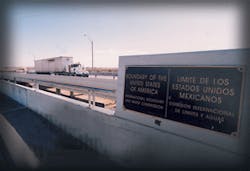The Automated Commercial Environment (ACE) and its related e-manifest, which will be mandated at all U.S. Customs and Border Protection (CBP)-controlled truck clearances at land-port crossings, promises to accelerate the flow goods across the border for all trucks, but by how much may depend on how tech-savvy an individual fleet is.
This is one of the many variables that the American Transportation Research Institute (ATRI) is considering as it conducts an efficiency assessment of ACE, thanks to CBP funding. The potential productivity gains fleets might allegedly achieve come from electronically automate cargo data to function in tandem with operational and ACE regulatory requirements, according to ATRI – compared to today’s system whereby fleets fax or transmit cargo manifests to brokers, who then enter the data into CBP systems.
“In a separate study…[we found that] medium to large fleets are investing [in technology] as smaller fleets sit back and wait,” Dan Murray, ATRI vp of research told FleetOwner. “If you applied that study to border crossings it [may end up that] ACE [is] more beneficial and accepted by medium and large fleets while smaller fleets will probably still rely on brokers and mediators to take advantage of the technology. That’s a hypothesis, but if you applied that research to the ACE study, that might be substantiated.”
Yet for now, ATRI is far from drawing conclusions as to whether ACE might improve cross-border freight flows. “When you look at statistics that show sheer numbers of crossings, it looks like efficiency and productivity has improved,” Murray said. “Carriers that routinely haul goods across the border seem to indicate that efficiency has not improved. We’re trying to separate fact from fiction in the efficiency in border crossings.”
It should be noted that solid U.S. economic growth over the past two years alone would increase raw numbers of commercial truck border crossings. But regardless of whether increases in cross-border freight activity could be credited to ACE efficiencies or not, the ATRI study is a positive step for CBP to show it is serious about making it so.
“During 2002 and 2003 when the U.S. economy was pulling out of a recession, Alan Greenspan said that it was productivity gains that kept us out of a depression,” Murray said. “Our interest is trying to see what role technology can play in improving productivity. [The ATRI study will] be able to quantify the benefits and opportunities versus a manual system—and show what are the opportunities for improving border crossings.”
